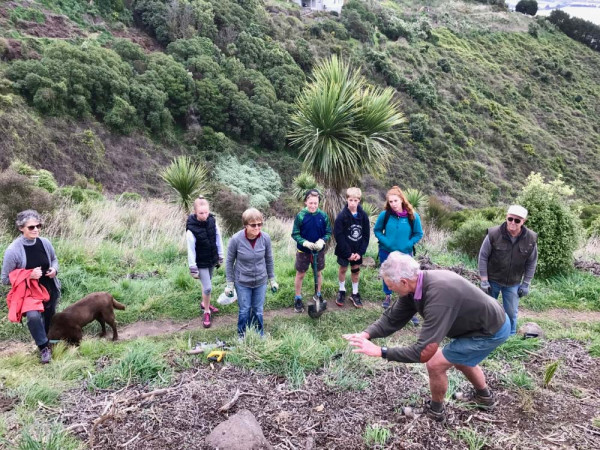Plants
General
Humans have evolved (over the last 100,000 years) with plants and forests and depend on them for many things including: food; materials; medicines; clean water; soil stabilisation; carbon dioxide uptake; oxygen production; dust and pollen filtering; animal habitat; shelter; healing; recreation; tourism and cultural identity.
On the global scale, some scientists are now advocating that we must return to 50% of the original temperate forest cover to help stabilise the climate and reduce species decline. New Zealand is in the temperate climatic zone and whereas 80% of the country was in native forest before humans arrived (700-800 years ago), currently native forests cover less than 25%, and even worse, this is mainly in mountainous areas. In Canterbury, the percentage remaining is even less, which helps to explain our problems with water quality and quantity, flooding, soil loss, allergens, and reduced biodiversity with many species being endangered or locally extinct.
A further concern is the increasing types and numbers of exotic (introduced) plants. Whereas we have in NZ about 2,500 types of native flowering plants, we also have over 2,500(and increasing) types of exotic “wild” plants and another more than 20,000 types of cultivated and garden plants. Many exotic plants are “invasive” (including some exotic forest species) and take over habitats of native plants.
Many of our native plants have evolved here over millions of years and are unique to New Zealand, which makes them globally important for protection. In addition they have evolved with our native animals, insects and soil biota and are ideally suited to them, unlike most exotic plants. Further, our native plants provide a critical cultural value because they help to establish our local sense of place or identity, a central part of human well-being. This is part of what we can authentically market as true Aotearoa-New Zealand, for tourism and produce.
As a nation, we have yet to establish a sustainable relationship with our native plants and see them as our natural heritage and care for them for the present and unknown future benefits they may provide. We also have an international duty to look after the world’s treasures (taonga) that are specific to us: no one else can.
In Drayton Reserve we aim to return a large portion of a major local water catchment to original native forest, return native biodiversity and reduce the number of exotic plants. This is an important part of rebuilding a viable presence of our unique nature and restoring natural character and ecological integrity to a part of the Port Hills of Christchurch City.
Species
There will be several hundred native species eventually established in the Reserve. At present there are less than 100 but there are numerous introduced (exotic) species including many pest or invasive weed species. Local weeds and organic control methods are listed on the Weeds page. Most of the original native plant species are listed under ecosystems below.
Ecosystems
There are eight different ecosystems within the Reserve, each distinguished by land features; e.g., altitude, slope, soil, aspect and moisture. Within each ecosystem can be different types and combinations of species as listed in this document.
Restoration
There are no mature native trees in the Reserve, indicating that all original trees must have been felled or burnt to enable livestock grazing. The Council have undertaken some revegetation with original species in terms of a 1998 Concept Plan, but survival rates have been low except on some parts of the moister slopes.
In view of the lack of mature and sufficient native trees, low numbers of native birds which could disperse seed, low diversity of species and extensive areas of exotic grasses and weeds, the following strategy of manually controlling weeds and planting of native species will apply:
- Delineate the likely original ecosystems in the Reserve, based on altitude, slope, soil, aspect, moisture etc. and identify the species that occurred in these ecosystems.
- Use seedlings from locally eco-sourced seed, since these are adapted to local conditions and will grow better, be less prone to disease and will maintain the genetic integrity of the locality. Most seedlings are supplied by the City and Regional Councils and Trees For Canterbury (where you can donate to Drayton Reserve and equivalent value in seedlings will be supplied to us).
- Clear the worst weeds off a well-defined area each autumn for planting. See the clearing and pruning specification document.
- Plant fast-growing native tree species at high densities to quickly shade the ground and supress weeds (these will generally be medium height or under-storey tree species). See the planting specification.
- Stake trees, water regularly in the first summer to encourage deep root growth and clear and mulch surrounding weeds each spring and autumn to retain moisture for 2 or 3 years. See the seedling clearing specification and the watering specification documents.
- After 5 or so years or when the under-storey tree branches are touching and shading the ground, plant tall or canopy tree species and pockets of native ground-cover species which will naturally spread.
- Where canopy species have already been planted in open situations, clearing of surrounding weeds and mulching may be required for several years.
- Low combustibility local native plant species will be established near property boundaries.

Monitoring
Records will be maintained for seedling types and numbers planted, land areas planted, seedling mortality, sample tree growth rates, carbon sequestering and panoramic photos will be taken annually at defined points throughout the Reserve. In addition, some plants in the Reserve will be given name stakes for visitor information.
